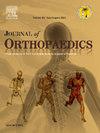Outcome of posterior short segment fixation with implanting pedicle screw at the fractured level for treatment of thoracolumbar fracture
IF 1.5
Q3 ORTHOPEDICS
引用次数: 0
Abstract
Introduction
Thoracolumbar fractures make up majority of the spinal fractures. Various techniques including long, short, mono and short segment screw fixation have been used to achieve stability. There are still few studies describing the results of short segment fixation with intermediate screw fixation in fractured vertebrae, despite the fact that all have adequate efficacy and stability.
Materials and methods
41 patients were studied and evaluated preoperatively, at discharge and at 2, 6, 12, 24 weeks and 1 year follow-up clinically using Greenough and Fraser Low Back Pain Score, the American Spinal Injury Association (ASIA) grading, four-point scale questionnaire for patient's satisfaction, sagittal index (SI) of injured vertebra and Cobb's angle.
Results
The patient's mean age was 36.9 ± 11.7 years, majority (90.2 %) with lumbar (L1-L3) segment involvement. All the patients significantly improved neurologically immediately after surgery (p < 0.001) however the improvement was not significant at final follow up (p = 0.3) as compared to the preoperative ASIA grade (Kendall's tau-b test). Low back pain decreased significantly on subsequent follow-up as measured by Visual Analogue Scale (VAS) score (p < 0.001). The Low Back Pain Scale of Greenough and Fraser calculated at immediate post-operation and at 1 year follow up in comparison to pre-operation status showed a statistically significant improvement (p < 0.001). Sagittal index (SI) estimated at 6, 12, 24 weeks and 1 year follow-up in comparison to preoperative SI was higher and statistically significant (p < 0.001). Mean Cobb's angle significantly decreased during follow-up at 6, 12, 24 weeks and 1 year compared to preoperative angle (p < 0.001). Four Point Scale Questionnaire assessed at 1 year follow-up showed majority (82.9 %) were very satisfied with the outcome.
Conclusion
Posterior short segment with intermediate screw fixation in fractured vertebra is a feasible and stable treatment method for traumatic single thoracolumbar fracture with respect to the functional outcome, patient satisfaction and preservation of motion segment.
在骨折水平植入椎弓根螺钉进行后路短节段固定治疗胸腰椎骨折的效果
导言 背腰椎骨折占脊柱骨折的大多数。为获得稳定性,人们采用了各种技术,包括长、短、单和短节段螺钉固定。尽管所有技术都有足够的疗效和稳定性,但描述短节段固定和中间螺钉固定治疗骨折椎体效果的研究仍然很少。材料和方法 采用格林诺夫和弗雷泽腰痛评分法、美国脊柱损伤协会(ASIA)分级、患者满意度四点量表问卷、受伤椎体的矢状指数(SI)和柯布角,对41例患者进行了术前、出院、2周、6周、12周、24周和1年的临床随访研究和评估。手术后,所有患者的神经功能立即得到明显改善(p <0.001),但与手术前的ASIA分级(Kendall's tau-b检验)相比,最终随访时的改善并不明显(p = 0.3)。根据视觉模拟量表(VAS)评分,随访期间腰痛明显减轻(p < 0.001)。格林诺夫和弗雷泽的腰背痛量表(Low Back Pain Scale of Greenough and Fraser)显示,与手术前相比,手术后即刻和随访一年时的腰背痛情况有明显改善(p <0.001)。术后6周、12周、24周和随访1年时的矢状面指数(SI)与术前相比更高,且有统计学意义(p <0.001)。与术前相比,6周、12周、24周和1年随访期间的平均Cobb角明显下降(p <0.001)。结论:就功能结果、患者满意度和保留运动节段而言,后路短节段中间螺钉固定骨折椎体是治疗创伤性单发胸腰椎骨折的一种可行且稳定的方法。
本文章由计算机程序翻译,如有差异,请以英文原文为准。
求助全文
约1分钟内获得全文
求助全文
来源期刊

Journal of orthopaedics
ORTHOPEDICS-
CiteScore
3.50
自引率
6.70%
发文量
202
审稿时长
56 days
期刊介绍:
Journal of Orthopaedics aims to be a leading journal in orthopaedics and contribute towards the improvement of quality of orthopedic health care. The journal publishes original research work and review articles related to different aspects of orthopaedics including Arthroplasty, Arthroscopy, Sports Medicine, Trauma, Spine and Spinal deformities, Pediatric orthopaedics, limb reconstruction procedures, hand surgery, and orthopaedic oncology. It also publishes articles on continuing education, health-related information, case reports and letters to the editor. It is requested to note that the journal has an international readership and all submissions should be aimed at specifying something about the setting in which the work was conducted. Authors must also provide any specific reasons for the research and also provide an elaborate description of the results.
 求助内容:
求助内容: 应助结果提醒方式:
应助结果提醒方式:


